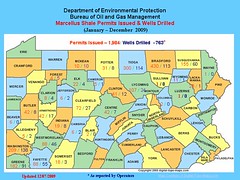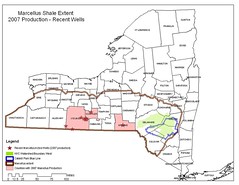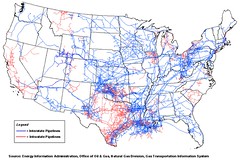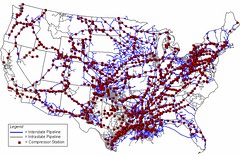Posted on June 2, 2010
 The U.S. Environmental Protection Agency (EPA) has taken a significant step toward making more chemical health and safety information available to the public even as trade secrets claims continue to conceal such information elsewhere. A new EPA policy will reject most industry claims that chemical identities included in health and safety studies are trade secrets. Meanwhile, the oil and gas industry continues to use trade secrets privileges to thwart attempts to disclose chemical information related to the BP oil spill and controversial natural gas drilling operations.
The U.S. Environmental Protection Agency (EPA) has taken a significant step toward making more chemical health and safety information available to the public even as trade secrets claims continue to conceal such information elsewhere. A new EPA policy will reject most industry claims that chemical identities included in health and safety studies are trade secrets. Meanwhile, the oil and gas industry continues to use trade secrets privileges to thwart attempts to disclose chemical information related to the BP oil spill and controversial natural gas drilling operations.
On May 27, the EPA announced a new "general practice" where the agency will review all claims by manufacturers that a chemical's identity should be treated as confidential business information (CBI) when the identity is part of a health and safety study or the study's underlying data. The agency expects that unless the disclosure of the chemical identity explicitly reveals how the chemical is produced or processed, the secrecy claim will be rejected, allowing the public to link the chemical to its health and safety information.
This is the third recent major action by EPA to rein in overuse of trade secrets claims by the chemicals industry under the nation's primary chemicals statute, the Toxic Substances Control Act (TSCA). Earlier, the agency announced that chemical identities that were public in the TSCA inventory (a list of more than 83,000 chemical substances) could not be claimed as trade secrets and that the agency would provide free access to the inventory, which had only been available for a fee.
According to EPA, the new practice "is part of a broader effort to increase transparency and provide more valuable information to the public by identifying data collections where information may have been claimed and treated as confidential in the past but is not in fact entitled to confidentiality under TSCA." By late August, EPA plans to begin reviewing new and existing confidentiality claims for chemical identities found in health and safety studies, as well as associated data.
TSCA generally prohibits chemical health and safety information from being withheld from the public. Up to this point, however, the public might have had access to the health studies but not the identity of the chemicals the health studies referred to, rendering the studies and data practically useless. The practice of claiming chemical identity as CBI has been widespread at EPA despite regulatory language that clearly states that "chemical identity is part of, or underlying data to, a health and safety study" and also states, "Chemical identity is always part of a health and safety study."
EPA "believes that Congress generally intended for the public to be able to know the identities of chemical substances for which health and safety studies have been submitted." EPA announced that it "believes these actions will make more health and safety information available to the public and support an important mission of the Agency to promote public understanding of the potential risks posed by chemical substances in commerce."
EPA further acknowledges that TSCA was not intended "to limit the uses of information from a health and safety study" by keeping the public – including a chemical company's competitors – in the dark about chemical identities. Manufacturers have argued that their competitors could use disclosed chemical identities to learn about the proprietary manufacturing processes. EPA has rejected this argument, stating that "[disclosing] the end product of a process (i.e., a chemical identity) is not the same thing as disclosing the process to make that end product."
Oil and Gas Drillers Push for Secrecy
Despite EPA's actions, the disclosure of chemical identities remains a major issue on other fronts. At a recent House Energy and Commerce Committee mark-up, an amendment to the Safe Drinking Water Act that would have required the disclosure of the identities of chemicals used in a near-ubiquitous natural gas drilling process called hydraulic fracturing was withdrawn by its sponsor (Diana DeGette, D-CO) following strong industry criticism.
Hydraulic fracturing (or fracking) is a process where water, chemicals, and other materials are pumped under high pressure into a well to create and prop open fissures in underground rock, thus allowing trapped natural gas to flow out and be recovered. Fracking chemicals may include known carcinogens and other toxins.
Hydraulic fracturing, which was exempted from federal regulation in 2005, is linked to numerous cases of groundwater contamination. Fracking fluids may also leak or spill on the surface, creating additional ecological and public health threats. The House measure, sponsored by Rep. Diana DeGette (D-CO), only would have required the chemical constituents used in hydraulic fracturing to be posted on the Internet, with no other federal regulations placed on the process.
Another fracking disclosure measure is included in the discussion draft of climate change legislation now pending in the Senate. The language in the climate bill and other measures would only require disclosure of chemical constituents, imposing no other regulation of natural gas drilling. Regardless, the oil and gas drilling industry has fought vociferously against the disclosure of the chemicals being pumped underground, claiming the information is proprietary.
The day after the House mark-up, during which DeGette withdrew her disclosure amendment, a subcommittee of the same House Energy and Commerce Committee held a hearing to examine the BP oil spill catastrophe in the Gulf of Mexico. The poor flow of information to the public and Congress was a topic of concern.
Significant concerns have been raised regarding the use and identity of chemical dispersants on the BP oil spill. The dispersants are chemicals that attempt to break down oil before it can reach the shoreline. So far, BP has used more than 980,000 gallons of dispersants. The identities of the chemicals being poured into the Gulf of Mexico are considered to be trade secrets, and the EPA has not released this information to the public. The toxic effects – both short-term and long-term – of the dispersants are not fully understood. Scientists remain concerned about the ultimate fate of the chemicals and how they travel and interact with marine life and other chemicals in the Gulf.
EPA states, "All the information EPA can make public about these dispersants can be found on the Product Schedule. Some of the ingredients are listed as confidential. This is because the manufacturer has chosen to keep this information proprietary, and as a result EPA is obligated to withhold this information."
Both the general rules EPA uses to make CBI determinations and the specific rules that apply to TSCA's CBI determinations contain emergency provisions that allow the EPA to disclose CBI under conditions where public health and the environment face "imminent and substantial danger" or "an unreasonable risk of injury."
The chemical reportedly being used by BP to disperse the oil is banned in Britain but approved for use in the United States and Canada. Recent reports of fishermen becoming ill after possibly being exposed to the dispersants, combined with the unprecedented quantities of dispersants being used and the unique situation involving their use at extreme ocean depths, would seem to qualify the situation for the same level of openness that EPA is applying to chemical identities elsewhere. As the EPA made clear in describing its new TSCA CBI policy, without knowing what the chemicals are, researching their impacts is considerably more difficult.
DEMAND ACCOUNTABILITY!
Write to your Senators and Representatives in support of public health and safety. Demand disclosure legislation now!



















No comments:
Post a Comment